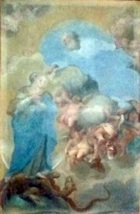

Santa Caterina Vecchia
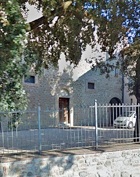
The original Benedictine nunnery of Santa Caterina was established in the 13th century on a site about 1 km outside Porta Sant’ Angelo. In 1248, a lady called Benvenuta di Cilino di Assisi made bequests to a number of nunneries in Perugia:
-
✴Sant’ Angelo di Arenaria (or del Renaio), near Cenerente (some 4 km outside Porta Sant' Angelo), which later transferred to San Francesco delle Donne;
-
✴Santa Maria di Monteluce; and
-
✴Santa Caterina.
Pope Clement IV consecrated the nuns’ church in 1265. In 1382, the nuns were given responsibility for the reformed prostitutes at Santa Maria Maddalena.
In 1487, Pope Innocent VIII removed both Santa Caterina and Santa Maria Maddalena from episcopal supervision, at the request of the nuns, and placed them under the protection of the Cassinese monks of San Pietro. In 1507, Pope Julius II confirmed the privileges of Santa Caterina and broke its association with Santa Maria Maddalena. The link was subsequently and intermittently restored until 1590, when it was definitively broken.
The complex was open to attack during the siege by Tuscan soldiers in the War of Castro (1643), so the nuns moved to a new site within the city wall. They found hospitality at San Francesco delle Donne and then at Santa Maria Maddalena, before moving to what became known as Santa Caterina Nuova in 1649. Their nunnery was demolished to ensure that they could not return. Their church survives and has been adapted for secular use.
Art in Santa Caterina Vecchia
Frescoes (early 17th century)
These frescoes in the presbytery, which are attributed to Cristoforo Roncalli, il Pomarancio, depict:
-
✴the Trinity with saints and angels, in the cupola; and
-
✴the four Evangelists, in the pendentives.
The presence nearby of the arms of the Cantagallina family suggest that they might have been associated with the commission: Orazio Cantagallina made other donations to the nunnery in 1603-13, when his two daughters were nuns here.
Frescoes (1620)
The frescoes in the vault of the nave are dated by inscription. A second, now-illegible inscription recorded the name of the donor, Cristina degli Oddi. The frescoes depict:
-
✴six of the theological and cardinal virtues; and
-
✴three scenes from the life of St Catherine of Alexandria.
These frescoes can be securely attributed to Cesare Sermei on the basis of surviving preparatory sketches in Biblioteca Comunale, Assisi.
Etruscan hypogeum (1st century BC)
This hypogeum, which consisted of two or three small rooms, was discovered near Santa Caterina Vecchia in 1869. It contained four travertine urns:
-
✴the inscriptions of a man called Presnte and his mother were in Etruscan; and
-
✴those of his wife, Hastia Aemili Praesenti and another lady were in Latin, so they probably post-dated the municipalisation of Perugia in 89BC.
The urn of Hastia Aemili Praesenti is exhibited in the upper cloister in the Museo Archeologico. A number of objects (3rd or 4th century BC) that were found nearby are exhibited in the Early Etruscan Section of the museum. These are obviously much older than the hypogeum, and must have been heirlooms.
Santa Caterina
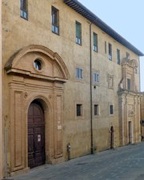
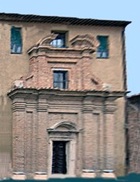
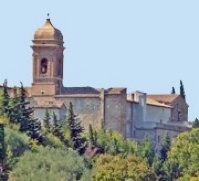
Church of San Bernardo
The original nunnery here seems to have belonged to the nuns of San Francesco delle Donne in the 16th century, when it was dedicated to St Clare (Santa Chiara). The Cistercian nuns of Santa Giuliana bought it in 1547 because they feared that their original nunnery was to be demolished to make way for the Fortezza di San Cataldo, part of the new Rocca Paolina. They commissioned Galeazzo Alessi to design a new church and nunnery; a payment that they made to him in 1548 relates to the preparation of a design and a model. Cardinal Tiberio Crispo laid the foundation stone of the church, which was dedicated to St Bernard.
The planned Fortezza di San Cataldo was reduced in scale when Rocca Paolina was redesigned. The nuns' fears for Santa Giuliana were therefore not realised, and they never moved here. The complex was used instead, from 1595 until 1622, for the Collegio di San Bernardo, which formed part of the Episcopal Seminary. In 1622, it passed temporarily to a community of reformed Carmelites, who used it while they built their new church and convent of Santa Teresa.
Change of Dedication
As noted above, the church took on its present dedication in 1649, when the nuns moved here from Santa Caterina Vecchia. They seem to have modified the facade:
-
✴reliefs of St Catherine’s wheel appear on each side of the door to the left that leads to the nunnery.
-
✴the portal bears the date 1648.
The nuns formally transferred to their new church and nunnery in 1649.
In 1702, the monks of San Pietro asked to be relieved of responsibility for the nuns, and Pope Clement XI duly placed them once more under episcopal control in the following year.
The church was re-modelled and re-consecrated in 1720.
The community was suppressed in 1810-15. It absorbed the nuns from San Benedetto dei Condotti in 1820, but was again suppressed in 1860. Part of the nunnery was demolished in the late 19th century to make way for the Staffa factory, which manufactured matches. The nuns subsequently returned, and the surviving buildings now house the only community of Benedictine nuns that survives in Perugia.
Interior

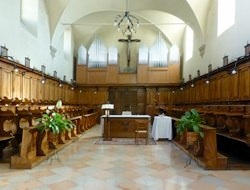
Church Choir
The church has a single nave, a semi-circular tribune and a large retro-choir.
Scenes from the life of St Catherine of Alexandria (1718)

Altarpieces attributed to Benedetto Bandiera (17th century)
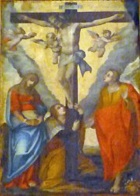
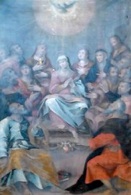
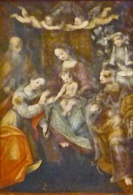
The works in Santa Caterina that are attributed to Benedetto Bandiera include altarpieces depicting:
-
✴the Crucifixion with the Virgin and SS John the Evangelist and Mary Magdalen (on the 1st altar on the left);
-
✴the descent of the Holy Spirit (on the 1st altar on the right);
-
✴the mystical marriage of St Catherine with saints (on the 2nd altar on the left); and
-
✴the martyrdom of St Ursula (now in the convent, not illustrated above).
The third of these was taken to Rome in 1812 but restored to Santa Caterina five years later.
Immaculate Virgin (early 18th century)
Art from the Church
Mystical Marriage of St Catherine (ca. 1530)
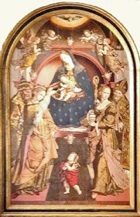
The altarpiece depicts the Madonna and Child enthroned, with a dove representing the Holy Spirit above and the young St John the Baptist below. SS Catherine of Alexandria and Peter stand to the left, and St Mary Magdalene and a bishop saint stand to the right. The Madonna holds the hand of St Catherine while the baby Jesus places a ring on her wedding finger.
